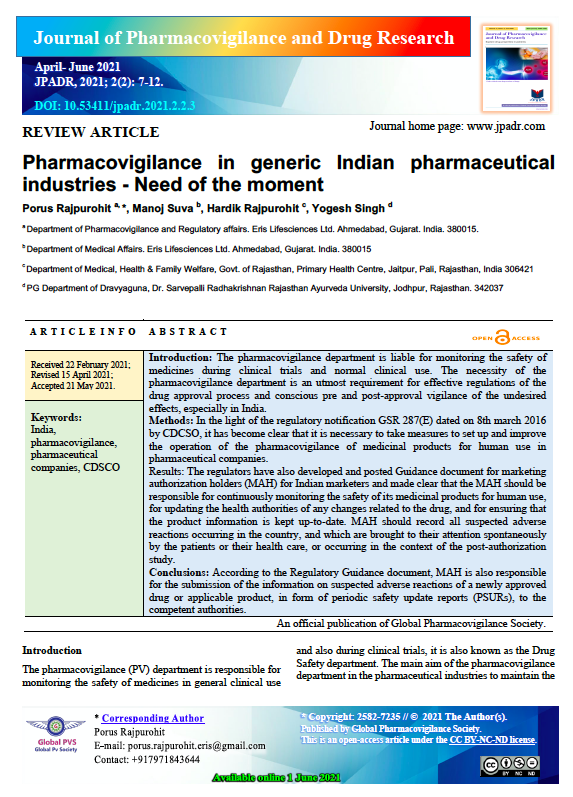Pharmacovigilance in generic Indian pharmaceutical industries - Need of the moment
Abstract
Introduction: The pharmacovigilance department is liable for monitoring the safety of medicines during clinical trials and normal clinical use. The necessity of the pharmacovigilance department is an utmost requirement for effective regulations of the drug approval process and conscious pre and post-approval vigilance of the undesired effects, especially in India.
Methods: In the light of the regulatory notification GSR 287(E) dated on 8th march 2016 by CDCSO, it has become clear that it is necessary to take measures to set up and improve the operation of the pharmacovigilance of medicinal products for human use in pharmaceutical companies.
Results: The regulators have also developed and posted Guidance document for marketing authorization holders (MAH) for Indian marketers and made clear that the MAH should be responsible for continuously monitoring the safety of its medicinal products for human use, for updating the health authorities of any changes related to the drug, and for ensuring that the product information is kept up-to-date. MAH should record all suspected adverse reactions occurring in the country, and which are brought to their attention spontaneously by the patients or their health care, or occurring in the context of the post-authorization study.
Conclusions: According to the Regulatory Guidance document, MAH is also responsible for the submission of the information on suspected adverse reactions of a newly approved drug or applicable product, in form of periodic safety update reports (PSURs), to the competent authorities.
Downloads
References
Arora D. (2008). Pharmacovigilance obligations of the pharmaceutical companies in India. Indian journal of pharmacology, 40(Suppl 1), S13–S16.
Basu, S. (2018). Risk-based program for pharmacovigilance inspections of market authorization holders (MAHs) for human medicinal products. CDSCO Notice, Dated 27-Sep-2018.
Bhati, N., Kannan, S., & Khosla, P. P. (2015). Good pharmacovigilance practice: Need of the hour from pharmaceutical companies. Perspectives in clinical research, 6(3), 171–172.
Freifeld, C. C., Brownstein, J. S., Menone, C. M., Bao, W., Filice, R., Kass-Hout, T., & Dasgupta, N. (2014). Digital drug safety surveillance: monitoring pharmaceutical products in twitter. Drug safety, 37(5), 343–350.
Gagnon, S., Schueler, P., Fany, J. (2012). Pharmacovigilance and Risk Management, Global Clinical Trials Playbook, Sec 4, 141-159.
Grady C. (2005). Payment of clinical research subjects. The Journal of clinical investigation, 115(7), 1681–1687.
Indian Pharmacopoeia Commission. (2017). Pharmacovigilance Guidance Document for MAHs of Pharmaceutical Products. NCC-PvPI, IPC, 2017. Version 1.0
Kalantri, S. P. (2003). Ethics in clinical research. Indian journal of anaesthesia, 47(1), 30-32.
Khattri, S., Balamuralidhara, V., Pramod, K. T., Valluru, R., Venkatesh, M. P. (2012). Pharmacovigilance regulations in India: A Step forward. Clinical Research and Regulatory Affairs, 29(2), 41-45.
Ministry of Health and Family Welfare. (2016). The Gazette of India: Extraordinary G.S.R. 287 (E) Notification, 2(2), 1-4.
Nautiyal, S. (2017). Sixty pharma cos submit ADRs reports in XML format mandated by PvPI. Pharmabiz, 2017; April 13, 2017.
Radhakrishnan, R., Vidyasagar, S., Verma, M. D. (2011). An educational intervention to assess knowledge, attitude, practices of pharmacovigilance among health care professionals in an Indian tertiary care teaching hospital. International journal of pharmtech research, 6, 78–92.
Singh, G. N. (2017). Guidance for industry on pharmacovigilance requirements for biological products. CDSCO Order, 27 Jan 2017, 1-52.
Suke, S. G., Kosta, P., & Negi, H. (2015). Role of Pharmacovigilance in India: An overview. Online journal of public health informatics, 7(2), e223.
Venkatraman, J. V. (2017). New Pharmacovigilance Obligations for MAHs in India. Regional Reports, 2017.
World health organization. (2002). The importance of Pharmacovigilance Safety Monitoring of medicinal products. World Health Organization, 2002.
World health organization. (2004). Pharmacovigilance: Ensuring the Safe Use of Medicines. WHO Policy Perspectives on Medicines, Oct 2004:01-05.
Yadav S. (2008). Status of adverse drug reaction monitoring and pharmacovigilance in selected countries. Indian journal of pharmacology, 40(Suppl 1), S4–S9.

Copyright (c) 2021 Porus Rajpurohit, Manoj Suva, Hardik Rajpurohit, Yogesh Singh

This work is licensed under a Creative Commons Attribution-NonCommercial-NoDerivatives 4.0 International License.









